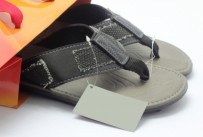No Flip Flops

No Flip Flops
Written by: Paul Kochoa, PT, DPT, OCS, CKTP, CGFI
I had a patient come in this past week complaining of foot pain. She had worn flip flops for most of the summer, but didn’t have any issues until a couple weeks ago. Flip flops are bad. They go hand in hand with summer, but they do a number on your feet. Let me explain.
When you walk around, showing off your new manicure with your flip flops, going out shopping in the mall or walking around the city, your feet will be cursing you. When you walk with flip flops, your big toe has to flex a bit to keep them on, much more so if you try and pick up the pace and walk faster. Go ahead, try it, try walking fast with flip flops on. That flexion of the big toe really messes up the mechanics of the foot.
If you’re a regular reader of this website, you’ve probably heard of the plantar fascia. It’s an important tissue structure in the bottom of your foot. Coupled with the flexing and extending of the big toe, you can make that fascia tight or loose. This tightness gives the foot its stability when walking, but too much tension isn’t good. Take a look at your foot, if you’re sitting, you can flex and extend your toe freely. When you flex your toe, the two points where the plantar fascia attaches get closer together and the plantar fascia gets loose. When you extend the toe, these two points get farther apart and the plantar fascia gets tight. The fancy term for this interactive structure is the “Windlass Mechanism”. It allows the bottom of the foot to remain as a stable base when you go to push off your big toe when you’re walking around.
Normally when you step forward with one foot, your heel of the other foot comes off the ground first, that places the big toe in that extended position, and tightens up the windlass mechanism, creating a proper and stable foot platform for muscles to use. When the windlass mechanism is messed with, like when you try and crinkle up that toe to hold on to a flip flop as you walk, that creates too much tension in the whole lower part of your foot which can cause connected problems up the leg, into the ankle, calf, knee, and maybe even into the hip.
Besides the mechanical changes in the foot that the flip flop can cause, there’s also the decreased support to the arch when you’re just standing. No arch support creates more tension and stress on the tendons and muscles that run up the inside of the arch and up the inside of your ankle. This can cause more problems up into the calf resulting in pain and tenderness into the calf muscle or the Achilles tendon.
Remember, take care of your feet so that they can take care of you.
If you would like more information, please call Professional Physical Therapy and Training at 973-270-7417. Our offices are located within the YMCA locations in Madison and Summit, NJ. You do not need to be a member of the YMCA to visit with us.
Image courtesy of Naypong / FreeDigitalPhotos.net